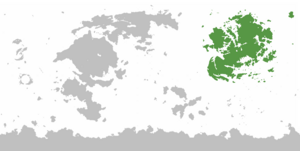Europa (continent)
- "Europa (continent)" redirects here. For other uses, see Europa (disambiguation)
 | |
| Area | 40,500,000 km2 (15,600,000 sq mi) |
|---|---|
| Demonym | Europan |
| Countries | List of countries |
| Languages | List of languages |
| Time zones | UTC+5 to UTC+10 |
| Largest cities | |
Europa is a continent of Eurth bordered by the Argic Ocean to the north, the Adlantic Ocean to the west and the Oriental Ocean to the south and east. The closest other continent is Argis, across the northern polar region.
Etymology
Europa means "land of the father" in Proto-Europan.
WIP. Explain the other names and meanings.
History
WIP
- 2000 BCE: Azanian Iron Age. Mountainous area, with iron coming up from the ground. Source of a classical civilisation with trade routes.
- 15,000-5000 BCE: Amutia was green until 5000 BCE. Its called the Amutian humid period. Plenty of space for oases, bedouins, caves, wadis, cacti.
- Integrate parts of Zande people and Swahili naval history for Azania/Zongla.[1]
- Etymology of Azania based on !Ezana of Axum. Could be a precursor to the Archaeminoan dynasty and/or the Hereskus empires.
- And use the cool Benin Bronzes as illustration. This can lend credence to the earlier mentions of Azanian mercenaries being active in the Aroman Empire.
Geography
The continent is situated entirely in the eastern hemisphere, and most mostly in the Northern Hemisphere. Only a part of Noble Nykia and the Meteorolan archipelago extend south across the Equator. The maritime borders consist of the Argic Ocean to the north, the Adlantic Ocean to the west and the Oriental Ocean to the south and east. The closest continents are Argis across the northern polar region, Thalassa to the east, and Marenesia to the south.
WIP. Mountains. Highest peaks. Climate zones.
The continent of Europa is divided into several important regions or subcontinents, especially the large peninsulas separated from the main continental landmass by geographical features.
- Occident in the northwest, largely based on remains of the classical Aroman Empire. (!Greek cultures).
- Burania (Aroman: north) in the northeast with colder climates. Historically, the interior is home to nomadic steppe cultures. Along the coasts there live seafaring culture. (!Anglo-Germano-Russo-Fennoscandian cultures).
- Orient (Aroman: rising) in the east and southeast is focused on trade between kingdoms and archipelago (!Sino-Indian cultures).
- Amutia (from Aroman Αμμουδιά, meaning sand sea) is the large central desert, hammered by the punishing rays of the San. Its fields of dunes are broken by gravel plains and volcanic outcrops, shimmering under hazing heat. This makes it difficult to travel from northern to southern subcontinents. The terrain is dotted with oases. Nevertheless, the Amutian desert has been described as "army devouring". But there is water to be found underground, trapped in depressions or beneath the wadis where the occasional flash flood rumbles by. It is around these oases and spring that desert people settled and farmed. (Mixed cultures).
- Azania in the southwest is one of the oldest continuously inhabited places on Eurth. The exonym Al-Zanj (Sahrabic: زَنْج), meaning "land of the black people", was used by Ancient Memopotamian scholars to refer to this southern land and its inhabitants. According to early Aroman sources, the Azanian people possessed arguably the finest archers, but didn't favour discipline or an organised command hierarchy. Their patron animal was the leopard, which was depicted exclusively on royal banners. Two important subregions are:
- Memopotamia in the southwest has a long and difficult history, with countries such as Norrium, Yien, Abantium (!Semetic cultures).
- Zongla (Aroman: jungle) in the far southwest, with countries such as Afropa, Noble Nykia, Wajoka (!African cultures).
- Meteorola in the southeast is a broad archipelago that stretches between Azania in the west and the Orient in the east. The Meteorolan archipelago is an exonym from Aroma. It is an erroneous reference to high rock formations. In this case, it means islands that protrude above the water. The Aromans must already have had advanced knowledge of this area. The Meteorolan archipelago is home to several large islands and small archipelagos, divided into multiple countries. They vary from island to island in terms of governance. The islands share a common cultural heritage, all being of Azano-Marenesian origin and formerly part of the classical era thalassocratic Chulo Empire. These countries are small, remote and of relatively little interest in the mainland's affairs, unless they engage in war or disrupt trade.
Countries
The list below includes some countries falling even partially under any of the various common definitions of Europa, geographic or political.
 Abantium
Abantium Adaptus
Adaptus Akwisia
Akwisia Afropa
Afropa Akiiryu
Akiiryu Ayubi
Ayubi Bainbridge Islands
Bainbridge IslandsBashan
 Cabarria
Cabarria Cristina
Cristina Damak Var
Damak Var Deltannia
Deltannia Euandria
Euandria Faramount
FaramountGaellicia
 Great Anglia
Great Anglia Haruspex
Haruspex Hexanesa
Hexanesa Ide Jima
Ide Jima Kotowari
Kotowari Lysian Republic
Lysian Republic Mahana
Mahana Mantella
Mantella Mekabiri
Mekabiri Miiros
Miiros Norrium
Norrium Orioni
Orioni Qubdi
Qubdi Red Iberios
Red Iberios Safiloa (also considered part of Marenesia)
Safiloa (also considered part of Marenesia) San Ba
San Ba Sporsia
Sporsia Suverina
Suverina Tagmatium
Tagmatium Tamurin
Tamurin Volsci
Volsci Wajoka
Wajoka Yien
Yien Yuropa
Yuropa Zharr
Zharr
References
- ↑ The Swahili Culture (0 to 1500 CE) African History Documentary by Stefan Milo (26 October 2019)
